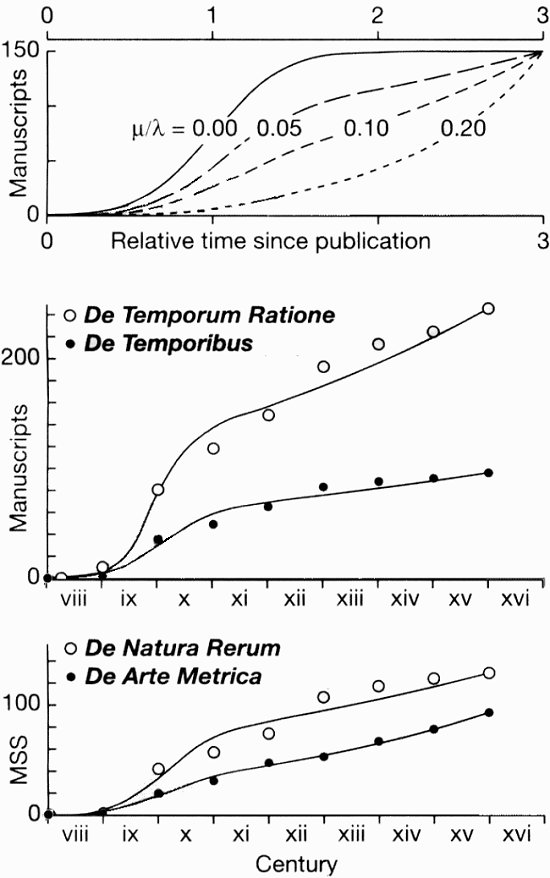Manuscript Demography
Today, manuscript demography. The University of Houston's College of Engineering presents this series about the machines that make our civilization run, and the people whose ingenuity created them.
Earth scientist John Cisne asks us to view the survival of old manuscript books the way we view living populations. Books are made and they die off -- by fire, floods, book burnings, or even by recycling. In that, they really are like human or animal populations. They might thrive, ebb, or become extinct.
Of course we especially worry about extinction -- of books as well as living creatures. The old hand-copied manuscript books may've been more vulnerable to extinction since, before the printing press, far fewer were made. Still, if the population's birth rate was less, so too was the rate at which they perished.
Cisne studies this process using the tools of a mathematical statistician. If we know how many books are created per existing book, and how many die, then his math shows us how many copies will exist at any time. Unfortunately, he knows how many books have survived, but he does not know the birth and death rates.
That means he has to use his math in reverse. Cisne shows us how this works for a particular author. Medievalists can tell him how many of the Venerable Bede's books existed at any date. (Bede was an early eighth-century English monk, and a remarkable all-around scholar. He wrote about everything.)
Cisne applies his math to four of Bede's better-known books. One was a widely-used book about dates and calendars. Cisne back-calculates a birth-to-death ratio and he gets thirty-to-one. Just before the printing press, that'd brought the number of existing copies to around 250.
The birth-to-death ratio for another Bede book on the art of poetry was only fifteen-to-one. Only a hundred or so existed when Europe switched to print. And what about extinction? Only three out of Bede's forty or so books have been lost.
Naturally we wonder why medieval books had such low death rates. One reason is that copies were expensive and precious. But they were also written entirely on parchment. That made them very durable. The British didn't switch over to less expensive, and more vulnerable, paper until they began printing their books.
That brings up another twist: Survival rates for the ancient literature are much worse. With so many of Bede's books surviving, why do so few of Plato's, Hippocrates' or Galen's books remain? ' Well, they were all written on papyrus. Papyrus is a fine writing material, but it's vulnerable to all the same dangers that beset paper.
Last week I passed a campus loading dock and saw a huge pile of bound journals being sent off for recycling. Duplicated elsewhere and taking up space, I suppose. But that didn't stop my gut from clutching. Cisne's math goes out the window in today's notions of value. And, in the end, too much does parish, right under our noses. Just see how far you have to look to find an intact copy of an early issue of Life or Time magazine.
I'm John Lienhard, at the University of Houston, where we're interested in the way inventive minds work.
J. L. Cisne, How Science Survived: Medieval Manuscripts' "Demography" and Classic Texts' Extinction. Science, Vol. 307, 24 Feb. 2005, pp. 1305-1307. I am grateful to Carol Lienhard for proposing this as an Engines topic.
C. W. Jones, Bede, The Venerable. Dictionary of Scientific Biography.Vol. I (C.C. Gilespie, ed.) (New York: Chas. Scribner's Sons, 1970).

Graphs adapted from Cisne: In the top graph, we see how Cisne's predicted effect of ratio mu/lambda, the death/birth rate for books, affects the accumulation of manuscripts over the centuries. In the lower two graphs, Cisne compares his model with data for four of Bede's more technical books, De Temporum Ratione, de Temporibus, de Natura Rerum, and de Arte Metrica. In each case he determined a mu/lambda ratio by choosing the curve that best fit the data.

Top of a French page from the Gospel according St. Mark, dated AD 1230. This is from a parchment manuscript. (Note the first three letters of the Evangelist's name, MARCUS, at the top. That means that this is a left-hand page. The letters CUS would appear on the right-hand page.)

Top of a Gutenberg Bible printed in 1455 or 1456. This is paper. (Note that this is a nearly perfect imitation of the manuscript -- above -- from 225 years earlier. It lacks only the faint blue lines that the scribe used to guide his hand in making the manuscript copy.)
Both images courtesy of Special Collections, UH Libraries.